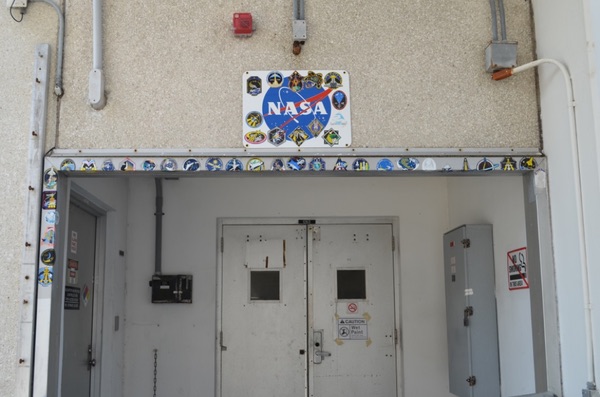Walking through the doors of history: unlocking a space traditionby Kirby Kahler
|
| When did the stickers start? Why were some missing? When did they start showing up? |
For the Apollo 50th reunion at KSC, I also took many photos of the famous astronaut walkout doorway and surrounding area as part of the NASA tour granted to a select group of “old space journalists.” There were no astronauts this time, just memories of the excitement and anticipation of seeing them walking through those iconic doorways. Those brave men and women were heading on the adventures of their lives, and they were taking us all with them.
This article is about investigating the O&C shuttle mission stickers that have been placed on the historic doorway, as noted in the photographs I took of the O&C walkout area. While many stickers seemed easy to identify, I noticed several immediately that could not be easily identified due to weathering and other issues.
I began this project by researching shuttle missions and patches for possible clues. I reviewed more than 130 shuttle walkout images/videos on NASA website, and YouTube. Most of the mission stickers and related data were identified online using comparisons with the NASA educational websites and shuttle mission patch photo databases. I used Wikipedia for general shuttle facts, as well as other information necessary to identify these weathered iconic stickers.
My questions were many: When did the stickers start? Why were some missing? When did they start showing up? These questions, and more, sparked my enthusiasm for solving this space history puzzle, and had now become a challenge…
 Walkouts of Apollo 7, STS-1, STS-87, STS-135, and Demo-2 (credit: NASA) |
The traditions: astronaut walkouts and mission stickers
One of the most exciting media events prior to a crewed rocket launch at KSC is the walkout of the astronauts after suiting up, then exiting through the double doors to their launch pad transportation.
The Apollo 7 astronauts began the tradition of suiting up and walking through the double doors numbered 1238 at the Manned Spacecraft Operations building to embrace the hundreds of camera clicks and flash activations. That tradition is still alive with the May 30 mission of the SpaceX Crew Dragon Demo-2.
Astronauts Bob Behnken and Doug Hurley walked proudly through the iconic double doors at the now Neil Armstrong Operations and Checkout building. These are the same doorways that astronauts from Apollo 7 first strolled through in 1968.
With the SpaceX Demo-2 mission, there were not as many cameras or flashes as the media was restricted due to COVID-19 precautions. The Astrovan transport to the pad was replaced by dual Tesla Model X SUV vehicles, the astronauts listening to music while being transported to the pad.
| While some stickers have faded over time, and others are very weathered, they all have a story to tell about the lives and missions of the shuttle astronauts. |
Built in 1964, the Manned Spacecraft Operations Building was renamed “Operations & Checkout Building” during the shuttle era. In 2014, it was renamed the Neil Armstrong Operations and Checkout Building in honor of the first man on the Moon. The building houses crew quarters, offices, laboratories, and also a large spacecraft assembly/testing facility where astronauts can practice for upcoming launches.
While there have been some changes, there is one tradition that has existed unchanged since shuttle mission STS-87: the astronauts personally placing their shuttle mission stickers above the iconic double doors of the O&C Building.
The posting of the first mission sticker at the O&C began with STS-87 on November 19, 1997. The decal first appeared directly in the middle of the doorway “head” prior to the mission. It is not immediately identifiable as it does not match in any of the sticker databases. This became Mystery Sticker 1, and needed further investigation.
Questions also arose considering this tradition and why it started with STS-87, as there were many prior shuttle missions. It was also discovered that there were two NASA signs with stickers, but NASA Sign 1 disappeared after STS-114.
There are now 44 mission stickers gracing the doorway and NASA 2 sign. On the left, middle, and right doorway, there are 30 stickers; while on the current NASA Sign 2, there are 14, including the SpaceX DM-2 Sticker. If you combine the five stickers from NASA Sign 1, and the STS-87 Mystery Sticker 1, the total is 50. They include STS-107, the shuttle Columbia mission that was lost during reentry on February 1, 2003. The mission sticker for Columbia STS-107 is present and in fair condition on the O&C doorframe.
While some stickers have faded over time, and others are very weathered, they all have a story to tell about the lives and missions of the shuttle astronauts.
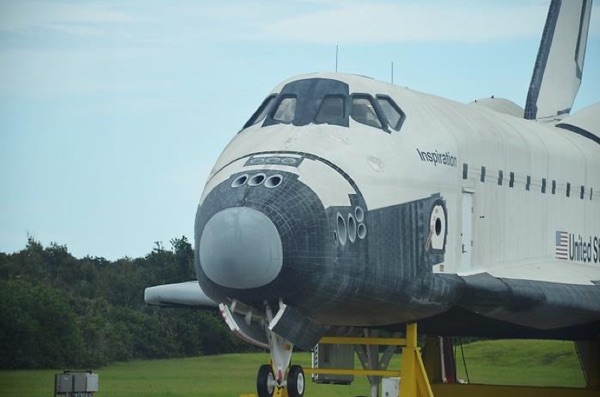 Shuttle “Inspiration” is a full-size mockup at the Shuttle Landing Facility. (credit: K. Kahler) |
Shuttle launch timelines and sequences
Initially, the mission stickers appeared to be randomly placed on the O&C doorway and signs. However, once you realize that the Shuttle missions didn’t always occur when they were scheduled, the placement of the stickers makes more sense.
Sequence of Shuttle Launches
1997: (81,82,83,84,94,85,86), 87*
1998: 89,90,91,95,88
1999: 96,93,103
2000: 99,101,106,92,97
2001: 98,102,100,104,105,108
2002: 109,110,111,112,113
2003: 107 (Columbia)
2004: None
2005: 114
2006: 121,115,116
2007: 117,118,120
2008: 122,123,124,126
2009: 119,125,127,128,129
2010: 130,131,132
2011: 133,134,135
2020: DM-2
*First Mission Sticker noted
Underlined: No sticker
Analysis of data: left head and jam
In order to report the results accurately, I needed to learn the correct nomenclature for the parts of a door. The horizontal beam above the doorway is known as the “head”; the vertical beam to the right and left of the doorway is called the “jam”. The ground-level horizontal beam is called the “sill”. There are no stickers on the sill, or on the double doors themselves (other than the occasional “Wet Paint” sign.)
When the astronauts walk through the double doors, they pass through a doorframe, which is an opening without doors. The Shuttle mission stickers have been attached to the doorframe’s head (no doors), right and left jams, and both NASA “meatball” Signs 1 and 2.
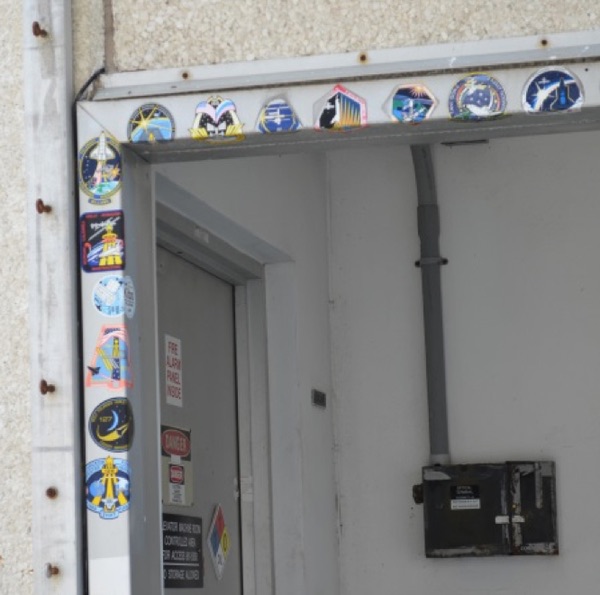 Shuttle mission stickers on left head and left jam. (credit: K. Kahler) |
Left Head - Mission Number/Launch Date (right to left)
- STS-100 – 04/19/01
- STS-108 – 12/05/01
- Unknown – See Identification Issue 1
- STS-110 – 04/08/02
- STS-112 – 10/07/02
- Unknown – See Identification Issue 2
- STS-115 – 09/09/06
Left Jam (top to bottom)
- STS-116 – 12/09/06
- STS-118 – 08/08/07
- Unknown – See Identification Issue 3
- STS-119 – 03/15/09
- STS-127 – 07/15/09
- STS-128 – 08/28/09
Analysis of data: middle head
 Middle section of stickers on the doorframe head. (credit: K. Kahler) |
Middle Head (left to right)
- STS-97 – 12/01/00
- STS-92 – 10/11/00
- STS-106 – 09/08/00
- STS-89 – 01/23/98
- STS-90 – 04/17/98
- STS-91 – 06/02/98
- STS-96 – 05/27/99
- STS-103 – 12/20/99
Analysis of data: right head and jam
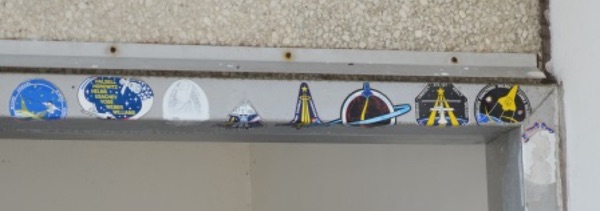 Mission stickers on the right head and right jam. (credit: K. Kahler) |
Right Head (left to right)
STS-99 – 02/11/00 STS-101 – 05/19/00 STS-98 – 02/07/01 (Severely faded) STS-111 – 06/05/02 STS-107 – 01/16/03 (Columbia) STS-114 – 07/26/05 STS-121 – 07/04/06 STS-120 – 10/23/07Right Jam
- STS-117 -06/08/07 (Torn off)
NASA “meatball” sign 1
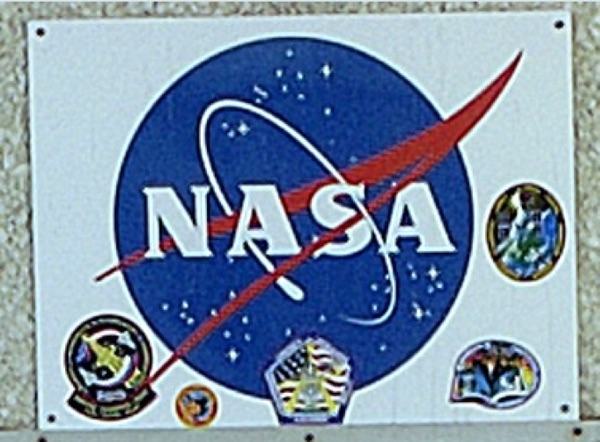 NASA “Meatball” Sign 1. (credit: NASA) |
There were two versions of the NASA sign seen in all of the shuttle astronaut walkout photos and videos: NASA Sign 1 and NASA Sign 2. This NASA Sign 1 first appeared for the STS-104 mission, and disappeared after STS-107.
NASA Sign 1 (in order of placement)
- STS-104 – 07/12/01 (middle center)
- STS-105 – 08/12/01 (left corner)
- STS-105 – ISS Expedition 3 Mission Sticker - 08/12/01 (Right corner)
- STS-109 – 03/01/02 (upper right)
- Unknown sticker; small, round, some colors visible between STS-104 & 105 stickers on left lower); See Mystery Sticker 2 section.
NASA “meatball” sign 2
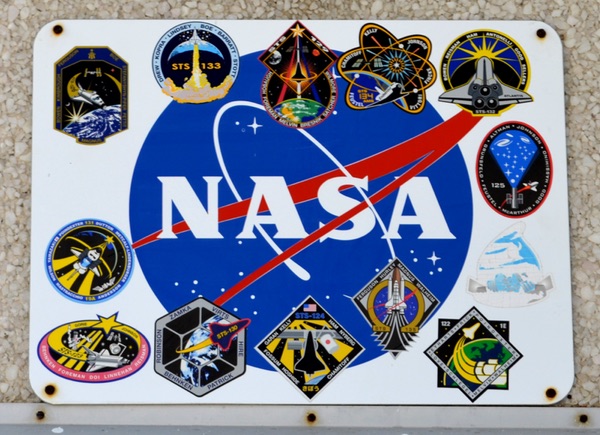 Current NASA “Meatball” Sign 2 without SpaceX Demo-2 mission sticker. (credit: K. Kahler) |
The NASA “Meatball” Sign 2 first appeared for the Shuttle STS-122 mission, February 7, 2008. The last sticker to be placed on this sign is the SpaceX Demo-2 sticker (not shown) which would be located under the STS-133 sticker (top left).
NASA Sign 2 (in order of placement)
- STS-122 — 02/07/08 (lower right corner)
- STS-123 — 03/11/08 (lower left corner)
- STS-124 — 05/31/08 (middle lower)
- STS-126 — 11/14/08 (upper left corner)
- STS-125 — 05/11/09 (upper right)
- STS-129 — 11/16/09 (middle upper)
- STS-130 — 02/08/10 (between STS-123/124 lower left)
- STS-131 — 05/05/10 (middle left)
- STS-132 — 05/14/10 (upper right corner)
- STS-133 — 02/24/2011 (left of STS-129)
- STS-134 — 05/16/2011 (right of STS-129)
- STS-135 — 07/08/2011 (between STS-122/124)
- Demo-2 — 05/30/20 (SpaceX – below STS-133) not shown
- Unknown sticker(above STS-122) – See Identification Issues #4
Identification issue stickers 1 through 4
The weathering effect on some of the stickers made them fairly difficult to identify. Using zoom and other photo effects made it easier to compare images against the database, but it is not always a consistent remedy.
There were four identification issues found at the beginning, but all were eventually resolved:
Identification Issue Sticker 1: Has five sides; shriveled; small image of spacecraft like ISS in center; sticker located near the left end of the doorway head. After researching all of the shuttle mission stickers, I looked at the ISS mission stickers. This was identified as the ISS Expedition #4 Mission patch from 12/07/2001. There were two American astronauts on board for STS-108, Daniel Bursch and Carl E. Walz. They got a ride home on STS-111.
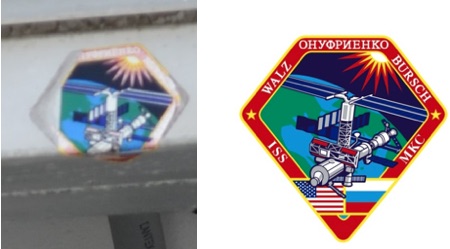 Left: sticker as seen in photo.00 Right: actual mission sticker for ISS Expedition 4. (credit: K. Kahler (left) and NASA (right)) |
Identification Issue Sticker 2: Degraded sticker; sculpted top; has 1 indentation with the 3 letters 'ISS'; no shuttle mission sticker matches. This was found to be ISS Expedition #5 from June 7, 2002. Peggy Whitson flew up on Endeavour, STS-111, and returned on Endeavour, STS-113. As she was the only US astronaut on the ISS Expedition, she would be most likely to have placed that sticker on the doorway.
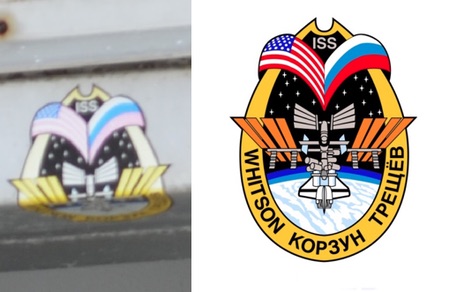 Left: sticker as seen in photo. Right: actual mission sticker for ISS Expedition 5. (credit: K. Kahler (left) and NASA (right)) |
Identification Issue Sticker 3: The angle of the photo allowed the word “Kibo” to be seen. The Kibo sticker is located on the lower left jam and was found to be from from STS-124, which also has a mission sticker on the doorway. Research showed that there were three Kibo lab module elements developed by the Japanese space agency JAXA, and were flown to the ISS on three missions: STS-123, STS-124, and STS-127.
 Original faded but could read “Kibo” (credit: K. Kahler (left) and JAXA (right)) |
Identification Issue Sticker 4: The “ice cream” sticker, as I first started calling it, reminded me of soft serve ice cream with a “coiffured” top. This sticker had faded to the point of very few recognizable features. There is an image of what looks like the ISS. It was first seen on the NASA 2 sign during the STS-132 walkout on 05/14/2010. Shuttle mission STS-132 had just launched nine days earlier on May 5, 2010.
 ‘Ice Cream’ photos, from left: 1. As-is; 2. Lightened; 3. Contrast added; 5. Bas Relief; 6. Actual Naoko Yamazaki mission sticker (NASA) (credit: K. Kahler) |
The identification for this sticker was elusive, but I kept reviewing mission sticker databases including ISS patches. No stickers seemed to be matching. I took screenshots of the sticker up close, and processed them through some photo filters to embellish any data.
I then began reviewing astronaut personal mission stickers on the Internet. I checked the shuttle mission rosters for that time period, and finally discovered the personal mission sticker from STS-131 (November 23, 2002) astronaut Naoko Yamazaki. The sticker seemed to be an exact match. She is a JAXA astronaut and had posted her sticker on the NASA Sign 2 across from the STS-131 sticker prior to the launch, and became part of history. Unfortunately, the sticker is barely recognizable now.
Mystery sticker 1: STS-87
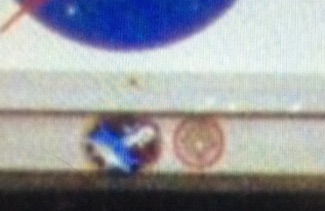 STS-91 (L) and Mystery Sticker 1 (R) (credit: K. Kahler) |
There were two unusually difficult mission stickers to identify. Mystery Sticker 1 went unnoticed at first, as it was only visible from mission STS-87 (November 19, 1997) through STS-91 (June 2, 1998). It is the first Shuttle mission sticker placed on the doorway of the O&C, and was not easy to identify from the start due to poor image quality.
For shuttle missions STS-87, STS-88, and STS-89, there was just the single sticker. Shuttle STS-90 (April 17, 1998) astronauts added their sticker to the doorway, placing it just to the left of the Mystery Sticker 1.
The walkout images from STS-91 (June 2, 1998) show three new stickers, and it became readily apparent that they are from missions STS-89, STS-90, and STS-91.
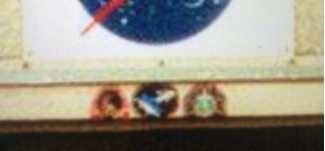 Three new stickers on the doorway (L to R) - STS-89, STS-90, and STS-91. (credit: K. Kahler) |
I drew diagrams to document visible patterns and colors. I knew that it was round, and had what appeared to be a thin, reddish outer circle. It was about three inches round, and had a half inch whitish area just to the right of center. No letters or numbers could be perceived.
I imported the image into Adobe Photoshop and Lightroom to apply filters such as bas relief and high/low contrast. Initially, this did not provide any additional information, secondary to the lack of image quality at high zoom.
| When all was said and done, it appears that some stickers did not get placed on the O&C doorway or NASA sign for one reason or another. |
I reviewed all of the mission stickers, personal astronaut patches, and other NASA databases for clues. As the sticker appeared prior to the STS-87 walkout, one would think it was from that mission. Unfortunately, STS-87’s mission sticker is ovoid in shape, and the Mystery 1 sticker is definitely round. I enlarged more photos of the original STS-87 walkout, and did the same for STS-89 and STS-90.
I began to look closer at the experiments onboard this shuttle mission, as many satellites and experiments also have a logo of some kind. I thought possibly that the larger projects might have more readily available mission stickers, and eventually found this to be true after reviewing many NASA ISS images.
Onboard STS-87 were a couple of large experiments: Marshall Space Flight Center’s USMP-4, a microgravity payload; and Smithsonian Astrophysical Observatory’s (SAO) satellite Spartan 201-4, a retrievable solar data satellite. The Spartan 201 satellite was flown into space five times aboard several shuttle missions.
I continued to draw additional pictures from the original image enlargement to try to extract any identifiable features. The only parts that continue to stand out is that it is about three inches round with a thin, reddish outer rim, and has a whitish area just to the right of center. More reviewing of databases, eBay auctions, and NASA archived images/videos took place. I tried reaching out to a couple of online resources but received no replies.
After taking a break from trying to identify this Mystery Sticker 1, I then again printed one of the enlargement photos and drew lines around any recognizable features. While the photo was fairly pixilated, there were some areas that stood out.
This time, I assembled all of the possible shuttle-type mission sticker images that were obviously round and had a reddish rim. I brought those images up on my iPad, and superimposed the printed Mystery Sticker 1 over each of them. Adjusting the size to match, it was immediately obvious that some of them didn’t match.
However, there was one that intrigued me. It was about three inches round, as compared to the known size of the STS-90 next to it. It also appeared to have a reddish rim, and a whitish object near the center. I reprinted the Mystery Sticker 1 enlargement again, this time with high contrast to expose the darker areas.
When this image was superimposed with the Mystery Sticker 1 image, it appeared to be a match! I believe that Mystery Sticker 1 is the mission sticker from Goddard Space Flight Center’s “Spartan 201” satellite. I also had the historical data that STS-87 mission had a direct link to this satellite, Spartan 201-4.
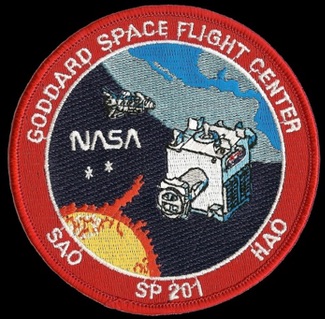 Goddard’s SPARTAN 201 mission patch. (credit: Spacefacts.de photo) |
Part of satellite Spartan 201-4 was SAO’s instrument engineered to collect data about the outer layers of the solar corona. It was designed to be retrieved from the shuttle cargo bay by the Canadarm robotic arm. The satellite could be released from the arm and later retrieved.
On November 21, 1997, STS-87 mission specialist Kalpana Chawla used the arm to deploy, and immediately try to retrieve, Spartan 201-4, when the satellite started to spin out of control. The issue was later determined to be a computer malfunction that caused Spartan 201 to lose the ability to control its spin.
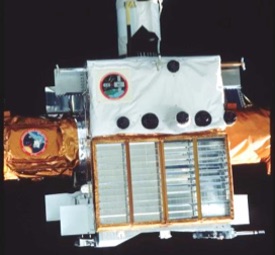 Spartan 201 Satellite grappled with the shuttle’s Canadarm. Mission sticker is located lower left on gold foil. (credit: NASA) |
The spinning satellite was successfully retrieved with an unscheduled, almost eight-hour spacewalk with two astronauts, and was not redeployed during that mission. It was returned via STS-87 and refurbished to be flown as Spartan 201-5 on STS-95, October 29, 1998.
The original five-mission Spartan 201 satellite is on display at the James S. McDonnell Space Hangar of the Steven F. Udvar-Hazy Center in Chantilly, Virginia.
Mystery sticker 2: NASA Sign 1
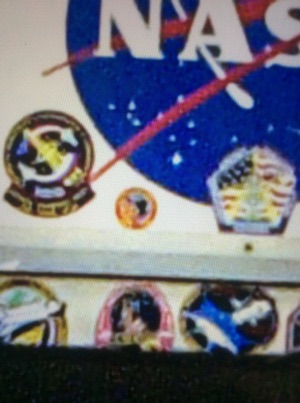 Small round mystery sticker on NASA Sign 1. (credit: NASA) |
The first sticker appeared on NASA Sign 1 on November 23, 2002, prior to the STS-113 launch. The STS-113 astronauts placed the sticker. It was the last mission before the ill-fated Columbia STS-107, which launched on January 16, 2003.
After the STS-107 Columbia disaster, NASA took a two-year hiatus to investigate the accident and make changes to the vehicle and procedures. NASA Sign 1 disappeared during the break, and was replaced with a brand new NASA Sign 2 prior to STS-114 (July 26, 2005). The STS-114 astronauts chose to place the decal to the right of STS-107 sticker on the right side of the doorway head, and not on the new sign.
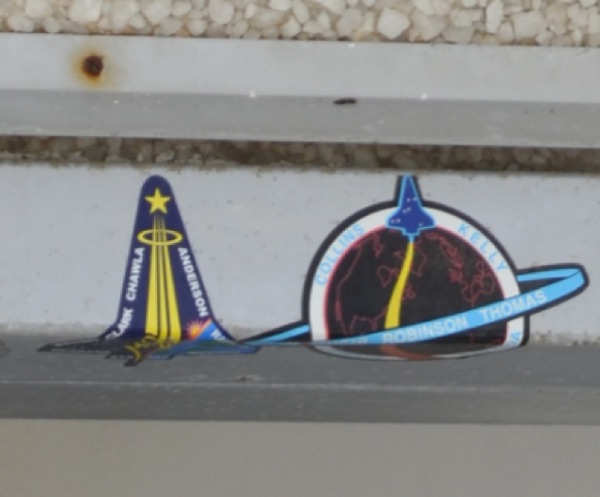 STS-107 and STS-114 mission stickers. (credit: K. Kahler) |
I had already identified all of the other stickers on NASA Sign 1, but this was a mission sticker that continued to perplex me in this challenge. I had researched most of the shuttle sticker databases multiple times, as well as the ISS Expedition resources. This sticker was difficult as the resolution of the walkout photos was insufficient to unveil any specific new details.
Again, I knew that it was small, about 2.5 inches in diameter, and seemed to have a large dark spot in the middle. There was an inner circle that was blueish in color. All I had was a screenshot of NASA Sign 1 so the image was fuzzy. As the sign has been gone since STS-114, it is difficult to reference.
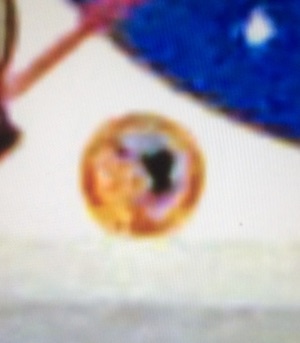 Mystery Sticker 2: Small, round sticker with various colors. (credit: NASA) |
I drew a few diagrams so I could easily compare it with the sticker database photos. There was really nothing like it that I could find, even on the military decal databases. I tried seeing if any shuttle astronauts had personal stickers, but to no avail.
I again set this issue aside to rethink other options. Most of the other stickers were fairly easy to identify, except for a few. This mystery sticker was becoming more difficult, and I was considering seeking outside help. At first I tried emailing the NASA graphic designer in charge of producing the artwork for most of the shuttle mission patches/stickers. Not hearing back from him, I continued to look at database pictures. I had pretty much given up on the idea of completing this puzzle challenge successfully.
I then reached out to one of the online mission sticker database administrators. I contacted Erik van der Hoorn, of https://www.Spacepatches.nl in the Netherlands, and he responded quickly. I exchanged the blurry photos I had of the mystery sticker, and he was able to identify it almost immediately. He sent me a picture of the real sticker and it read “Shuttle Crew Escape - NASA JSC”.
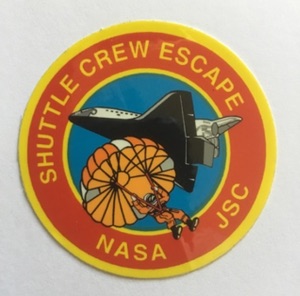 NASA/JSC Shuttle Crew Escape sticker. (credit: NASA) |
The sticker indicates an astronaut parachuting out of the shuttle during an abort situation. There appears to be three versions of these stickers: one with an orange-suited astronaut, one with a blue-suited astronaut, and one that says “Shuttle Crew Escape - Team Membe”. The team member patch was usually worn by the White Room Suit Techs. They were responsible for assisting the astronauts in suiting up and assuring all parts of their suits were working and in place.
The improved shuttle astronaut suits offered increased astronaut safety including individual parachutes as part of the new suits. The orange colored suit is an Advanced Crew Escape Suit (ACES), and uses the color “International Orange” for increased visibility, especially in the sea rescue environment. ACES were used by NASA from 1994 to 2011.
As part of the safety improvements after the Challenger STS-51L disaster, STS-26 (September 29, 1988) astronauts were the first to be trained in the new escape hatch for low-level abort situations. If a shuttle had an abort issue after liftoff, there were several options.
| One also has to wonder what will become of this historic, stickered doorway and current NASA sign. Many of the stickers are in poor shape, and more are just old and faded. These shuttle mission stickers were not designed to last this long. |
If the shuttle could not reach orbit or other immediate post-launch emergency, engineers surmised that the shuttle could glide to a lower altitude and speed, allowing the astronauts to clip their orange safety suits to a pole on the shuttle escape hatch opening, and then parachute into the ocean.
There were several military ocean recovery teams on standby for each shuttle launch, ready to support a rescue. If an ocean abort was necessary, their suits would keep them afloat until recovered. Fortunately, the ocean abort process was never needed during the history of the shuttle program.
Missing mission stickers
When reviewing the data, I noticed there were some missing mission stickers. When all was said and done, it appears that some stickers did not get placed on the O&C doorway or NASA sign for one reason or another.
Of the shuttle missions since the first sticker STS-87 was placed, there are no stickers visible for missions STS-88, STS-95, STS-102, STS-113, and STS-117. Again, it is unknown why this is, or even why the sticker tradition began with STS-87.
 Missing mission stickers (L to R): 1. STS-88; 2. STS-95; 3. STS-102; 4. STS-113; 5. STS-117. (credit: NASA) |
Conclusion
I enjoyed the challenge of solving this “Space Shuttle puzzle” and hope this information can be useful and entertaining. In the future, I would like to interview a few shuttle astronauts for their opinions on the sticker tradition, and develop a book based on this article. I think there are a lot more stories to tell, based on these current 44 mission stickers.
One also has to wonder what will become of this historic, stickered doorway and current NASA sign. Many of the stickers are in poor shape, and more are just old and faded. These shuttle mission stickers were not designed to last this long. I only hope that this physical piece of American space history can be preserved for all to see and appreciate. Few even know that this space tradition has even taken place.
In the years ahead, will they place new stickers over the faded and missing? Could they maybe add two new NASA signs, one to the right and one to the left of the current sign? Will they add all of the shuttle mission stickers? (I don’t think there is enough room.)
So, when you are watching the next crew walkout at KSC, keep an eye above the doorway at the Neil Armstrong Operations and Checkout Building for the placement of the newest crewed mission sticker.
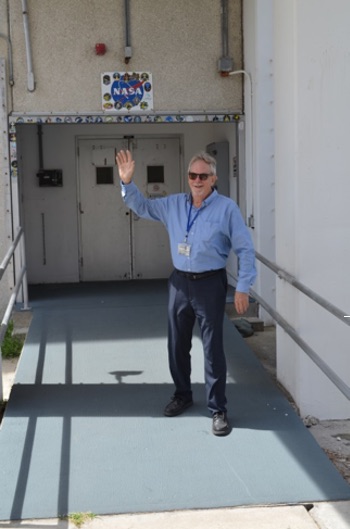 Author in front of historic KSC doors, July 2019 (Rachael Joy photo) |
Note: we are temporarily moderating all comments submitted to deal with a surge in spam.
